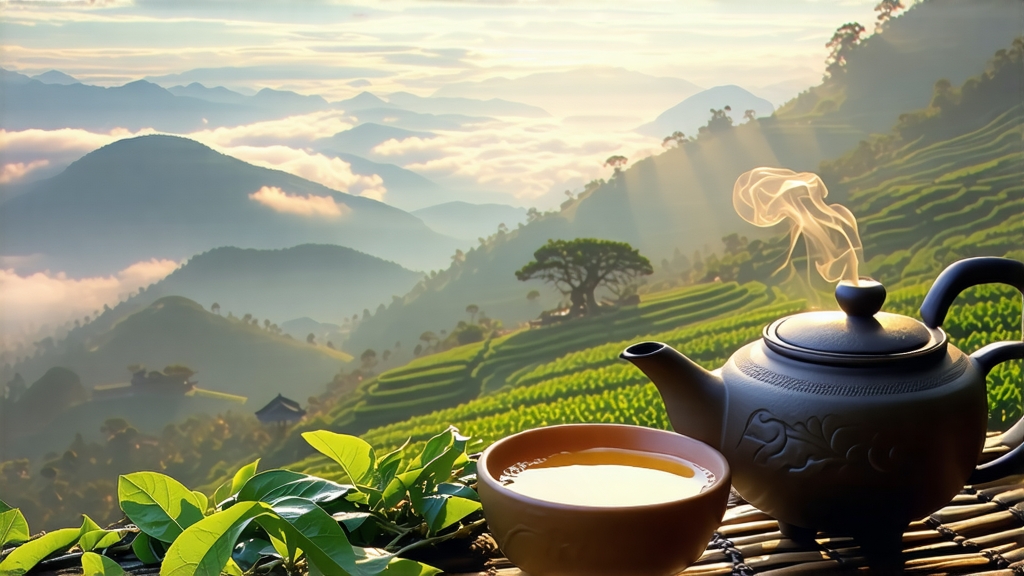
Alishan High-Mountain Oolong is the liquid echo of Taiwan’s central mountain range, a tea that carries the chill of cloud forest nights and the warmth of subtropical mornings in every curled leaf. First planted at elevations between 1,000 and 1,400 metres during the late 19th-century Qing expansion into the island’s rugged interior, the cultivar now known in the West as “Alishan” is less a single plant than a micro-climate in a cup. Its story begins when pioneering Hokkien settlers transplanted the hardy Qing Xin (Green Heart) bush from the lower foothills of Fujian to the granite spines of Chiayi County. There, the diurnal swing of 15 °C, perpetual mist, and ultra-violet-rich sunlight shortened the leaf’s growing cycle, condensing amino acids and aromatics into the tiny, jade-coloured pearls that define high-mountain oolong.
Strict Taiwanese regulation forbids the use of the name “Alishan” for leaves grown below 1,000 m or outside the designated townships of Meishan, Zhuqi, Fanlu and Alishan proper. Within this zone, three clonal sub-cultivars have emerged. Qing Xin remains the aristocrat, yielding a lilac fragrance and silky body. Jin Xuan (TTES #12), bred in 1981, adds a natural milk-cream note that foreigners often mistake for flavouring. The newest star, Cui Yu (TTES #13), ripens earlier and offers a brighter, orchid-like bouquet. Each is harvested by hand five times a year, yet the spring and winter flushes command the highest prices because cool nights lock in soluble sugars and volatiles that hotter seasons volatilise.
Plucking begins at dawn when dew still weighs the leaf, slowing oxidation and keeping cell walls intact. Two leaves and a bud are snapped with a downward tug that leaves the stem oblique, increasing surface area for withering. The baskets are then carried to low-slung, red-cedar factories where the leaves are solar-withered on large bamboo trays for 30–60 minutes, depending on cloud cover. This step is critical: too much sun and the leaf reddens like a black tea, too little and grassy aromatics persist. Next comes indoor withering on slatted racks, where conditioned air at 22 °C and 70 % humidity coaxes moisture from the stem while leaf enzymes begin converting catechins into the floral compounds linalool and geraniol. Every 30 minutes the tea master “rattles” the racks, bruising edges so that oxidation proceeds unevenly—half green, half amber—creating oolong’s trademark ombré leaf.
Oxidation is arrested at 25–30 % by tumbling the leaves into a 200 °C drum for 90 seconds, a flash-fix that locks in the high-mountain fragrance. While still warm, the leaf is wrapped in 12 kg cloth “balls” and sent to the shaping machine, a vertical pair of heated plates that compress and rotate the bundle for three minutes. The ball is opened, the leaf fluffed, and the cycle repeated 30–35 times over four hours, curling the leaf into the tight, pellet-like “dragon ball” that survives international shipping. Finally, the tea is dried at 80 °C until moisture falls to 3 %, then rested for 48 hours to let residual heat dissipate. Many lots undergo a light charcoal roast over longan wood, a 6-hour bake at 60 °C that adds chestnut depth without masking alpine florals; connoisseurs can choose “original fragrance” (unroasted) or “traditional taste” (roasted) styles.
To brew Alishan properly, begin with a 120 ml gaiwan or petite Yixing teapot. Use 6 g of leaf—about two heaping teaspoons—rinsed for five seconds with 95 °C water to awaken the compressed aromatics. Discard the rinse and infuse the first steep for 50 seconds, increasing each subsequent infusion by 10–15 seconds. High-mountain oolongs are famous for “seven infusions without fading,” but Alishan often stretches to ten, revealing a progression of gardenia, honeydew, white peach and, in roasted versions, toasted sesame. The liquor should glow like pale chardonnay; if it darkens toward amber after the third steep, lower the temperature to 90 °C